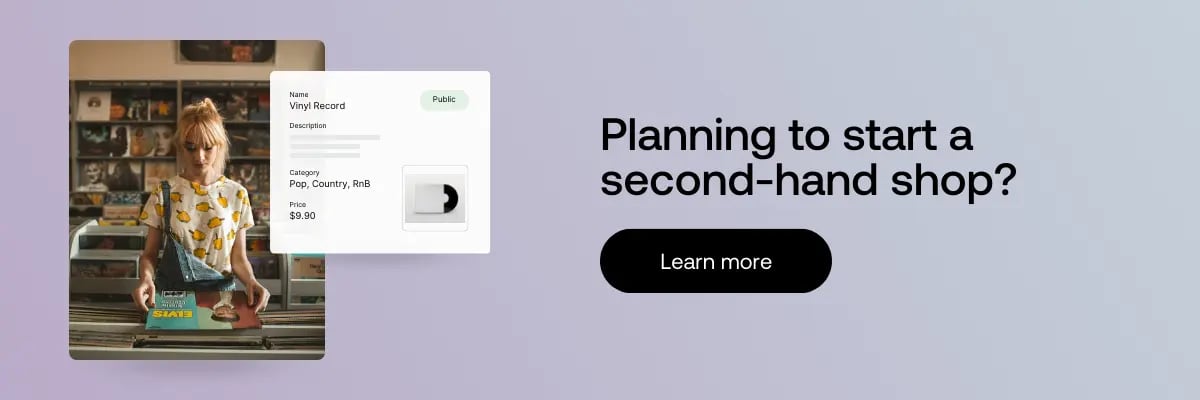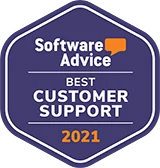Entrepreneurs seeking their next brilliant concept are likely to find the realm of reselling business ideas to be a captivating and promising space. It offers a pathway to remarkable returns without the traditional barriers typically associated with producing goods, such as extensive research and development budgets and trial and error.
Reselling has always played a significant role in the broader economy, but advancements in technology and a shift towards sustainability have propelled the resale market to grow at a staggering rate, outpacing traditional retail by eleven times.
This diverse market presents a lucrative opportunity for solopreneurs and established brands alike, with a vast array of items that can be resold for profit using various business models, including brick-and-mortar sales, branded online stores, and marketplaces. In this article, we explore the drivers behind the growing resale market, the various business model options for resellers, and how to overcome common challenges related to reselling business models.
The growth of resale markets
Products used to be manufactured with durability in mind. People would re-heel shoes and put patches on their coats. They'd pass down clothes between generations and bring electric goods and appliances for repair.
Fast fashion and planned obsolescence diverted us from this path. However, there are encouraging signs that society is embracing a kinder type of consumerism, including pre-loved goods.
While not all resale models incorporate secondhand goods, there are immense opportunities for entrepreneurs who want to embrace sustainable business practices. In recent years, reselling business models have helped circulate a wider variety of goods, and that trend is set to continue.
In 2021, 42% of Millennials or Gen X shoppers said they were prepared to buy secondhand goods. However, more recent data from the US puts that number at 93%. There are a few big reasons for these shifts in consumption preferences.
Inflation
Inflation and higher living costs have placed pressure on consumers worldwide. With grim economic outlooks the norm, shoppers are looking for value where they can. Used goods offer that value at a time when people need to make difficult financial choices.
Well-publicized supply chain problems in recent years have made producing and shipping global goods more expensive and complex. Raw materials and other commodities add costs to new items, meaning goods already in circulation can bridge the gap.
More awareness of the impact of consumerism
Greater access to information means consumers are informed about how their economic choices affect the environment. Consumers are making more positive choices as the public conversation around environmentalism and waste becomes louder. Purchasing goods with less impact on the environment has become more popular. Pre-loved items fit within this emerging outlook.
Access to luxury goods
Luxury goods are out of the price range of many shoppers. The secondhand market allows more consumers to buy these desirable items, often at a fraction of the original resale prices. Old taboos about buying pre-loved clothes have declined considerably in recent years, and consumers are shopping smarter.
Next, let's explore the various offline and online resale business models that can help you take advantage of these trends.
Traditional brick-and-mortar reselling models
Per Deloitte, brick-and-mortar retail businesses have declined since the financial crisis 2008. However, while there have been many highly publicized closures, the high street endures. Indeed, according to the same Deloitte report, vacancy rates have remained steady at around 12.5% since 2013. A large part of this resilience is due to the high street's ability to reinvent itself.
Brick-and-mortar reselling business models have been a considerable part of the retail economy for as long as anyone can remember. While a lot of the hype around the growth of reselling centers around online stores, the model can still work in more traditional retail settings.
If you're looking for a reselling business idea and like the idea of running a physical store, here are a few options worth exploring.
Discount Stores
Discount stores are a popular form of reselling business. The idea here is that by offering goods at significant discounts, you can attract customers looking for a bargain and, thus, increase your sales volumes. Of course, increasing your sales volumes is crucially important here because, typically, this model has tighter profit margins.
Discount stores are a classic recession-proof business. In fact, they tend to perform very well during economic downturns as consumers look for value.
The mechanics of discount stores involve buying items in bulk and selling them individually. However, unlike other retail stores, you don't have as much pressure to sell a comprehensive range of items. This flexibility means you can shop around for inventory and select items with the best promise of returns. For example, perishable items have the risk of spoilage attached. Instead, you can stock items that won't go out of date quickly, giving you enough time to turn a profit.
Thrift Stores
Thrift stores are another long-standing resale business model. These resale businesses involve selling used or pre-loved items at a significant discount. While many thrift stores are run in the interest of charity, others are for-profit businesses.
Donations are one of the most significant upsides of the thrift store business model. People are happy to give items to Goodwill or privately run stores to save them from going to a landfill. Otherwise, you can be more proactive about securing stock by going to estate sales, garage sales, and similar to buy stock. What's more, you can also get bulk purchases from bigger stores.
Buying secondhand has always had appeal for many shoppers. The unpredictability of stumbling across some clothing, books, or records that you love adds a unique dimension to the shopping experience. More people have come to the fold in recent years, hoping to find some of these great bargains.
The interesting thing to consider is that people who buy pre-loved items aren't necessarily low spenders. In fact, GWI research indicates that they typically have a 26% above-average purchasing power. However, what seems clear from GWI research is that these consumers are prepared to do some extra work to find a bargain. Thrift stores sit inside this framework because they involve more hunting and chasing to find the best deals.
Consignment Stores
Brick-and-mortar consignment stores can be an excellent way to enter the reselling business world. However, the most successful consignment stores generally focus on a particular niche or specialty.
The business model here is simple. You accept secondhand goods on behalf of one set of customers (sellers) and sell them to other customers (buyers), taking a commission or percentage of the overall price.
One of the big appeals of the consignment reseller business model is that it has a lower risk profile regarding inventory. Sure, you have expenses like rent, staff, and marketing, but you don't need to invest in stock. If items sell, you make a profit. If they don't, you can return them to the seller.
Consignment commissions are typically about 50%. However, these numbers can vary, especially for higher-value goods. Popular types of consignment stores include clothes, furniture, art, and antiques.
In many ways, a consignment store is a relationship business. You are an intermediary between people who want to sell products and those who want to buy them. Excellent knowledge or enthusiasm for a niche market can give you a significant edge. To a large extent, you can act as a broker of the deal between the buyer and the client.
Let's explore how this could work through the lens of a fine art resale dealer. Let's say you have a store or gallery and access to clients who want to sell paintings or prints. Your business will attract customers looking for particular types of pieces and connect the buyer and seller. Customer relationships are essential here, and it's just as much about cultivating trust from your target market as it is developing a good partnership with sellers.
Authentication capabilities constitute a significant advantage here. Art, like many industries, is subject to replica goods. People don't want to be defrauded of their income, so operating with a trusted, knowledgeable intermediary can add a lot of value for all parties in the transaction. While making this point about art, it still carries through in various industries, like clothes, sneakers, and antiques.
Digital reselling models
eCommerce has been one of the several headwinds that have changed the high street in recent decades. There are several advantages to opening an online business instead of its brick-and-mortar counterpoint, including access to a broader audience, lower overheads, and, in some cases, cheaper marketing.
Here are some online-only reseller business ideas you can explore for a healthy profit.
Branded resales
Branded resale is a traditional ecommerce model. It involves building your own website, selling online, managing inventory, and shipping products to customers. There are many moving parts compared to other digital reselling models. However, the profit margins can be higher.
We've seen several brands across different industries launching branded resale operations during the past few years. Some of the most notable examples include (but are not limited to) Patagonia, Apple, and Ikea. In addition to the global giants, the growth of the resale market is being driven by numerous smaller local online second-hand shops, thousands of which have been set up in the last couple of years.
The first thing you'll notice about these kinds of online shops is that they require expertise in a few different areas. First of all, just like any successful online business, you'll need to create a website with a pleasant shopping experience. Additionally, you'll need to know how to market your website to win customers. Quite basic things for any online seller.
The success of your online resale business depends on your ability to efficiently source pre-owned goods. Predicting demand is challenging, but so is predicting supply. In this business model, it's just as crucial to find sellers as it is to find buyers. You can achieve this by partnering with individuals or brands who are willing to sell their used items or surplus stock to you. Buy-back and trade-in programs are some of the ways to accomplish this.
Even though there are software tools designed for managing resale offerings, you must establish internal processes for reverse logistics, inspection, and grading to ensure that products are restocked and put back up for sale efficiently. Alternatively, you could seek out a partner to assist with the operational aspects of your branded resale business.
Compared to other forms of digital resale, the barriers to entry for this particular type are quite high due to the significant operational requirements. Despite this, choosing this model will provide you with greater control, and, considering the development of the resale market, investing in developing your own capabilities will definitely be worthwhile in the long run.
Dropshipping
Dropshipping is, without a doubt, one of the most profitable reselling business ideas around. The beauty of dropshipping is that you never have to touch the goods to have your own eCommerce business.
The biggest attraction of dropshipping is that it's very lean, requires minimal starting capital, and has low overheads. While these are clear advantages, they also make the space hugely competitive.
Purchasing and storing inventory are two significant business expenses. Dropshipping eliminates both, allowing the seller to focus on marketing and customer service.
The mechanics of dropshipping work like this.
-
Your customer makes an order
-
You inform the distributor or manufacturer
-
The distributor or manufacturer sends the product to the customer
What should become clear is that dropshipping is probably more about marketing than your typical reselling business. It's an excellent first step into eCommerce or entrepreneurship because of the low costs and low barrier to entry. The distributors physically stock inventory while you work on outreach.
The significant advantage of dropshipping is that it carries less risk than other types of reselling. Overheads are low because you aren't developing or managing inventory. In addition, you'll need less staff because you don't need to handle postage.
However, there are some disadvantages. Many drop shippers have run into issues when it comes to customer service. For example, if you sell items to a customer and they request a return, it's your responsibility. However, coordinating returns between your customer and the seller is no easy task.
Other drawbacks include a lack of control over product quality and scaling difficulties due to your reliance on suppliers. Managing demand can be complex. For example, suppliers can run out of products, forcing you to cancel customer orders.
However, despite the logistical complications involved, dropshipping endures because of the low entry barrier, startup costs, and access to a wide variety of goods. Another important point to consider is that if you can choose the right products, you can enjoy excellent profit margins.
Affiliate reselling
Affiliate reselling is another business model that allows you to market products for a distributor or manufacturer and take a chunk of the action. Again, the appeal here is that you don't need to worry about making and distributing your own products. Instead, it's about finding an audience.
Affiliate reselling can work in several different ways. But what is common to all of them is that you essentially become a marketing arm of the company. Affiliate sellers can focus on one product or brand or leverage their niche expertise to build a loyal audience that buys products based on their recommendations.
At heart, affiliate reselling involves promoting products online and taking a cut of any sales. Some of the significant advantages here are a low barrier to entry, minimal startup costs, and the flexibility to work with various brands.
How you approach affiliate reselling depends on how you can drive traffic to your affiliates. Internet influencers with large, engaged audiences frequently take advantage of affiliate programs. However, even smaller channels can have success with niche products. Product reviews and special interest websites can also benefit from affiliate reselling.
The basic mechanics of affiliate reselling involve posting links on your content that your audience clicks through when buying a product. From there, you get a percentage of the commission or a flat fee, depending on the specifics of the affiliate program.
Online marketplaces
Online marketplaces are one of the best ways to resell products online. While some of the more prominent names with the highest reach and traffic volumes include Amazon and eBay, plenty of alternatives have emerged in recent years.
One of the advantages of using these established platforms is that you don't need to set up your own store. Instead, these platforms will allow you to host a shop on their platform, which is a great way to test the waters without making a huge commitment.
The significant disadvantage of using these platforms is the high commissions. Average rates are between 15% to 20% of each sale. These commissions can eat your potential profits unless you are sourcing goods at rock-bottom prices. Another thing to consider is competition. If you're buying in bulk from a particular vendor, there is nothing to say a rival store can't set up and offer the same goods. Indeed, depending on their overheads, they might start undercutting your price, leaving you struggling.
On the upside, because these platforms are primarily search engine driven, you can draw a steady stream of customers if your SEO game is on point. You can build a loyal customer base and many positive reviews if you provide excellent delivery and customer service. This can allow you to compete on service rather than price.
Another thing to consider is that there are many specialist selling sites. For example, Vinted specializes in vintage clothing, accessories, and footwear, Poshmark deals in luxury goods, and sites like Chewy support reselling pet goods. Finding the right platform for your products can help you reach your target audience.
Social media
Social media platforms have emerged as credible ways to resell goods in recent years. The big plus here is reach, with platforms like Facebook boasting almost 3 billion monthly active users.
Facebook Marketplace is a great way to resell online. While it was only established in 2016, it has quickly become a trusted way to buy goods. Again, the barrier to entry is super low here, which makes it an excellent testing ground for new entrepreneurs. One of the big appeals is that selling locally carries no commission, while items that are processed for shipping mean that Facebook takes a 5% cut. Compared to other platforms, that's an acceptable price, allowing you to flip items for a profit.
Refurbish and resell business
The refurbishment and reselling business model is intriguing, especially for people with the knowledge and skills to restore items to their former glory. Refurbishment is different from other resale business models because potential returns are governed by your work on the goods that help transform their value.
Popular items you can refurbish include furniture, shoes, bags, electronics, tools, and more.
The basic mechanics of the refurbishment model
Refurbishment can be a profitable business model. However, it hinges on knowledge and skills. Each of these conditions must be met.
-
You need to know the rough value of a restored item.
-
You must be able to calculate the costs of a restoration or refurbishment.
-
You must be able to secure the worn or broken items at a low enough price to cover the costs of refurbishment and a profit.
Of course, you can also go directly to suppliers and bulk buy refurbished goods. While this can eat into potential profits, it eliminates the need for the technical skills required to restore the products that you sell.
Digital vs. physical storefronts for refurbished goods
A recent research paper, Show don't tell: Education and physical exposure effects in remanufactured product markets, explores the differences between digital and physical storefronts for refurbished goods.
The paper has a lot of great information, including the suggestion that refurbished goods require about 80% less carbon emission than newer products. Another interesting point suggests that profit margins for refurbished goods are around 40 to 80%.
While these figures might inspire you to rush out and start an online store selling refurbished items, the research found that shoppers were more likely to buy refurbished goods if they got to hold them in their hands. The paper uses the term "mere exposure" to explain the phenomenon, suggesting that trust can be driven by keeping the item in their hands and inspecting the quality.
Of course, the effects of "more exposure" must be offset by the higher overheads of running a physical business and the relative lack of reach. However, a brick-and-mortar store can still do brisk trade with the right location and enough foot traffic.
Hybrid Reselling Models
As you can tell, both online and offline businesses have advantages and disadvantages. At the same time, it's hard to argue with the additional reach that online offers, brick-and-mortar stores have higher customer loyalty rates. So, can a blend of digital and physical presences lead to better outcomes for resellers?
One of the big pluses of hybrid reselling models is that it allows you to reach customers on their terms. While some people prefer the convenience of online shopping, others want the experience of seeing and holding an item in their hands. As demonstrated above, physical interactions with goods can be a powerful driver. If you're selling pre-loved goods, this can make a difference.
In addition to running a brick-and-mortar store, offering an online outlet can help you reach new audiences. The COVID-19 pandemic forced many traditional retailers to explore online storefronts. The fact that most have continued to operate online is a testament to the utility of eCommerce stores.
Emerging trends in reselling
With 2024 approaching, it's an exciting time in the reselling space. Here is a look at what to expect in the new year in this emerging retail sector.
Technological innovations
Technology is at the center of the reselling revolution. It's allowed resellers and customers to connect in incredible ways and has gone a long way to democratizing the selling process. In the past, setting up a store required a huge investment and considerable expertise. These days, there is a wealth of information and advice available to budding entrepreneurs and, perhaps more importantly, a greater range of tools to make reselling much easier.
Twice is at the forefront of technological innovations that help power this more sustainable way of shopping. We built our platform to help anyone start a store, whether that's online, offline, or hybrid.
We help teams host their storefronts, inventory, and product catalogs in one place. However, we understand that's just one part of running a successful reselling business, so we also offer first-class store management to help fulfill orders and process payments.
Furthermore, we recognize the importance of hybrid reselling models. Our platform offers seamless integration with your website and various other channels, allowing you to effectively reach your target audience wherever they may be.
In 2024, we're introducing innovative tools that help solve many pain points facing modern reselling businesses. These tools include ways to.
-
Source items more efficiently
-
Manage inventory and generate actionable insights
-
Track the provenance of items to ensure their authenticity
-
Sell items in different channels, both on and offline.
Changing consumer behavior
Resale is one of the fastest-growing sectors in retail. In large part, that's down to shifts in customer behavior in recent years. While clothing accounts for almost half of all resale activity, other sectors will begin to make up ground in 2024.
Another notable factor in changing consumer behavior is a simple matter of demographics. As Gen Z and Millennial shoppers continue to make up a larger portion of consumers, their preferences will impact the market.
Taboos about buying used goods are vanishing by the week, and the emergence of credible platforms and websites is making the process more user-friendly and safe, which can help capture demographics that have been so far reluctant to participate in buying secondhand goods.
Challenges and solutions in reselling
Of course, if you want to start a reselling business, there are a few challenges that you need to be aware of. Here are some of the biggest points of friction you must contend with.
Handling inventory
Inventory is the lifeblood of your reselling business. Ensuring you track and manage your goods precisely is essential in an industry with tight margins. Manual tracking is time-consuming and subject to human error. Thankfully, many tools are available to help you run a smooth process.
Good inventory management is about more than tracking goods coming in and out. It's also about sourcing, storing, and selling them efficiently and making the best use of your warehouse space. New goods with barcodes are easy to scan into your system. Pre-owned items require inspection and grading systems, in addition to stock-level tracking, making the inventory management process a bit more complex.
The other huge benefit of digital inventory tracking is that it produces data you can use to your advantage. For example, you can integrate your inventory management software with your website, ensuring you only sell items you have in stock. You can also leverage this data to predict demand, ensure you buy goods at the right time, and minimize your warehouse space.
Establishing trust in secondhand and refurbished goods
One of the big reasons why people buy new goods is the perception that they will last for a long time, and even if they don't, they are backed up by multi-year guarantees. If you're running a shop selling pre-loved goods, you must find ways to bridge this gap.
Consumer rights for secondhand goods vary depending on the jurisdiction. However, some commonalities exist across the USA, UK, and Europe. For example, the goods must be as advertised. While some wear and tear are normal, faults must be declared upfront.
As a reseller, you can offer a guarantee on secondhand items. Secondhand video games and electrical goods retailers habitually offer 12-month guarantees against faults. This feature can help you win the trust of potential shoppers.
However, careful inventory selection and great reviews are the best way to win trust. Sure, it takes time to build a reputation, but it can translate to sales, especially on online platforms.
Managing overhead costs
Reselling businesses can be subject to tight profit margins, so you'll need to monitor overhead costs. Some models, like affiliate reselling and dropshipping, are attractive because they have low overheads. However, other models on our list involve significant investments in inventory, premises, staff, etc.
Fulfillment centers are a great way to outsource warehousing operations. These arrangements offer flexibility and an ability to scale, which is vital for a growing business. What's more, they reduce the burdens of employing dedicated staff. However, selecting the right vendor is crucial to drive down costs.
You'll also need to pay sales tax, marketing and advertising, utilities, insurance, etc. So remember to calculate these outgoings into your final prices.
Creating a sufficient supply of goods to resell
Perhaps the biggest challenge for resellers is having a reliable and steady supply of goods. With some retail models, such as buying in bulk and selling individually, products are always available, but not always at the price you want. For more ad-hoc selling situations, where you flip individual products, you're at the mercy of what you can find. Some weeks or months could see you turning down items at bargain prices, while in others, the market will seem to have little value.
Establishing relationships that give you access to items that you can flip for a profit is essential. What those relationships look like depends on your particular reselling model. However, be careful that you are not overly reliant on one source. Things can change quickly in the business world, and shifting prices or a lack of access can hurt your business. So, keep your options open.
Conclusion
Reselling is a great option for entrepreneurs who don't want to sink money into production. Perhaps more importantly, it provides access to a more sustainable business that ensures that goods that have already been produced stay within the market, find new homes, and stay out of landfills
Reselling is incredibly diverse. Various models are available to entrepreneurs, each offering advantages and disadvantages. Deciding which business model you choose depends on your existing skills. Dropshipping or affiliate reselling could be right for you if you're a great marketer. A brick-and-mortar reselling business could be more up your street if you're a people person.
Of course, if you have a great passion or interest in a particular niche, it can give you an immediate advantage. So, explore business models that will work best for your niche.
The final point is to find ways to add value if you want to stand out from your competitors. That could be through a customer loyalty program, excellent service, curated products, or access to rare goods. So find that thing that makes your store unique, and you'll have a great chance of success.









